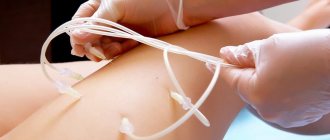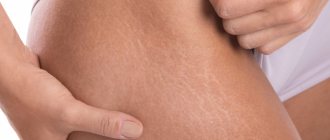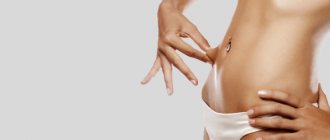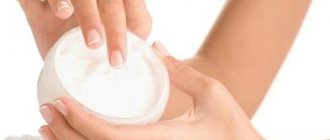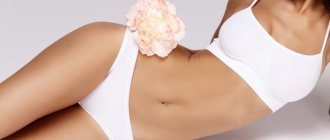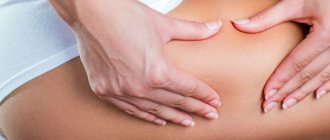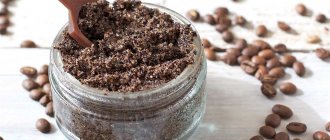Striae (stretch marks on the skin, striae distensae, stretch marks) are linear scars on the skin that usually develop on the body in places of linear stretching and can appear in people of any race and gender between the ages of 5 and 50 years. In women, stretch marks occur approximately twice as often as in men. Since stretch marks are essentially scar changes in the dermis caused by rupture of the connective tissue matrix, they persist for life. After pregnancy, stretch marks occur in 80–90% of cases, therefore, the International Classification of Diseases separately distinguishes stretch marks of pregnancy (EE30.10).
Since one of the main causes of stretch marks is overstretching of the skin due to rapid growth or increase in body volume, they often develop in adolescence, in bodybuilders gaining muscle mass, as well as in obese people. Striae can occur as a result of various diseases - for example, Cushing's and Marfan's syndromes. They also appear with long-term use of steroid hormones or their local application to the skin under occlusive (tight) dressings.
Striae are always localized on the body, and in pregnant women they usually appear in the abdomen and mammary glands; in athletes, they usually appear in the armpits, shoulders and thighs. In adolescents and obese individuals, stretch marks appear on the back, abdomen, legs and other areas, depending on which area of the body has sharply increased in size.
Unfortunately, despite many advances in the treatment of striae in recent years, there is no completely effective treatment for this skin condition. This situation is due to the fact that striae are already formed scar tissue of connective tissue fibers. Completely removing it and returning the original tissue again is a task that is currently beyond the control of a cosmetologist. In addition, it is necessary to approach the issue comprehensively, using several techniques sequentially or a combination of them. Unfortunately, the same technique cannot be universal in the treatment of any stretch marks.
Immediately after the appearance of striae, they are flat pinkish or reddish skin defects of short length - they are called striae rubra (red stretch marks, Fig. 1).
RICE. 1. RED STRIAE RUBRA.
Gradually, the defects mature and turn into white wrinkled scars - striae alba (white stretch marks, Fig. 2).
RICE. 2. WHITE STRIAE ALBA.
Typical striae alba have a length of up to several tens of centimeters and a width of 1 to 10 millimeters. They are a scar with a high density of connective tissue fibers and poor extensibility.
Based on the clinical picture, striae are classified according to stages of development and severity:
| STAGE | CLINICAL MANIFESTATION |
| Stage I | Fresh, inflamed, usually purple streaks |
| Stage II | White superficial grooves without gradation and without noticeable depression on the surface of the skin |
| II-b stage | White superficial grooves without gradation, but with a noticeable depression on the surface of the skin |
| III-a stage | White atrophic grooves with steps, less than 1 cm wide, without deep dyschromia |
| III-b stage | White atrophic grooves with steps, less than 1 cm wide, with deep dyschromia |
| IV stage | White atrophic grooves with gradations, more than 1 cm wide, with or without deep dyschromia |
Since stretch marks are mainly an aesthetic problem and do not cause patients other inconveniences characteristic of post-traumatic scars, such as discomfort and limited mobility, treatment comes down to a set of measures to reduce their visible manifestations. Hardware methods of influencing the skin, which have been actively developed over the past few years, in some cases show high effectiveness in the treatment of stretch marks. These include the use of the following types of lasers: CO2, Er: YAG, Er: fiber (Er: glass), diode, Nd: YAG pulsed dye, and excimer. There is evidence of the effectiveness of treating striae with devices that use intense pulsed light (IPL).
Among non-light techniques, radiofrequency exposure shows promising results - RF devices, both non-invasive and minimally invasive - needle-type. Based on the differences in the principle of operation of all of these devices, one can expect different effects and effectiveness in the treatment of stretch marks of different stages. Let's consider the methods that will be most effective in treating a certain type of stretch marks.
Red stretch marks (stage I)
These striae are in the formative stage, the inflammatory reaction in response to damage and active neoangiogenesis is the cause of visible manifestations - red and purple stripes. When treating such striae, it makes sense to direct the effect to reduce the vascular component, so selective destruction of blood vessels by heating hemoglobin will be effective. IPL and vascular lasers, such as dye and copper vapor lasers, are good options for treating stretch marks. At the same time, IPL therapy will be more convenient for the doctor and the patient, especially in cases where it is necessary to treat large areas covered with striae.
When treating red stretch marks with IPL, you can achieve their significant lightening after the first procedure, but you need to remember that this will be ineffective if the formation of stretch marks continues - new breaks appear and old ones increase. Therefore, when treating stretch marks red, it makes sense to make sure that the process of their formation is complete, and only then begin treatment: for example, when treating stretch marks after pregnancy, you should wait until your body weight stabilizes after childbirth and only then start IPL or laser therapy.
White stretch marks (stages II – IV)
Visually, white striae at any stage look like areas of tissue that are paler in relation to the surrounding skin. Therefore, one of the main tasks of their correction is to even out the color by smoothing the boundaries with the surrounding tissue. Skin surface remodeling techniques, primarily fractional photothermolysis, cope well with this task. Fractional ablative lasers destroy micro-areas of tissue along the entire length of the striae, as well as in healthy skin around it, by abruptly evaporating moisture in the cells, which leads to their instant overheating. During the healing process, a restructuring of the scar tissue of the striae itself and the surrounding dermis occurs, as well as renewal of the surrounding epidermis, migration of melanocytes to the stretch area and activation of melanin synthesis. Thanks to these processes, the surface of the striae begins to resemble the surrounding tissue more and more, and at the same time its width decreases. When treating atrophic striae, fractional photothermolysis procedures can also improve their relief: smooth out the gradation and raise the bottom of the striae to the level of the surrounding tissue. Fractional photothermolysis for the treatment of stretch marks always requires multiple procedures, and good results can be obtained when treating stretch marks of small width.
Wide stretch marks (III – IV stage)
It is important to understand that the surface of stretch marks, like the surface of any other scar, is devoid of skin patterns. Therefore, no measures using laser techniques can completely eliminate stretch marks, and they will be ineffective when it comes to treating widespread stretch marks. Even if a striae 10 mm wide (stage IV) is similar in color to the surrounding tissue and tans in a similar way, it will still stand out on the surface of the skin with shine and the absence of a skin pattern. The only effective way to treat wide stretch marks is surgery - plastic surgery with removal of a flap of skin and relocation of a healthy area. This method can be combined with laser procedures, since fractional lasers can improve scars left after plastic surgery.
What are stretch marks or stretch marks?
Stretch marks (striae) are a cosmetic defect that consists of atrophic scars on the skin in the form of strips of varying widths and lengths. Striae are colored from white to bright red and are most often localized in places of greatest extensibility of the skin: on the mammary glands, abdomen, buttocks, thighs, shoulders, back, etc. They can be either single or multiple, affecting large areas of the skin. Typically, atrophic scars in the form of striae are located at the same level with the skin surface, or have a retracted shape, creating a depression in the skin texture.
Stretch marks do not pose a health hazard, but this cosmetic defect causes serious emotional discomfort to their owners due to aesthetic unattractiveness.
About stretch marks on the hips
Stretch marks on the thighs can be noticed in many people. They look especially ugly on women. At the same time, representatives of the fair sex often have complexes, because each of them wants to look perfect under any conditions.
Stretch marks on the thighs form when the dermis (the second layer of skin) rapidly stretches, and the epidermis (surface layer) does not keep up with it. Stretching and then tearing, the dermis forms skin defects that are unable to disappear without a trace and are eventually filled with connective tissue. This is what stretch marks look like. Stretch marks on the thighs appear as thin, uneven lines on the skin, initially red, purple, and then white. Stretch marks can vary in length and width and are noticeable to a greater or lesser extent.
In order to eliminate stretch marks on the hips, women undergo treatment from professional cosmetologists, which allows them to completely forget about this disease and enjoy the health and beauty of their skin.
Why do stretch marks appear?
The reasons for the appearance of stretch marks are very diverse: significant fluctuations in weight, puberty with its inherent hormonal changes, pregnancy, endocrine diseases, long-term drug therapy, heredity, etc.
With a wide variety of causes, the mechanism for the formation of stretch marks is one, and it is associated with the process of disruption of the synthesis of collagen and elastin in the skin. Under the influence of provoking factors (rapid weight gain or muscle mass, pregnancy, hormonal imbalance, etc.), a situation of deficiency in the production of important proteins develops in the reticular layer of the dermis - collagen and elastin, which are responsible not only for the elasticity of the skin, but also the vascular wall. At the same time, the number of enzymes that destroy collagen and elastin remains the same. As a result, a pathological process develops in which the breakdown of the main framework proteins of the skin prevails over the rate of their synthesis, which leads to tearing and rupture of collagen and elastin fibers, as well as damage to the vascular wall of small capillaries of the skin. Therefore, at the initial stages of their development, stretch marks have a purplish-bluish tint. Then, at the site of the breaks due to the active synthesis of connective tissue, the stretch marks acquire a whitish-pearly hue. Unfortunately, this process is irreversible.
Is it possible to remove old stretch marks on the butt and legs?
Old neglected stretch marks, which have long since turned white, cannot be completely removed from the body. Sometimes, if it is absolutely necessary to remove them, they resort to plastic surgery and simply cut out the damaged areas, but this is a radical method and is only possible if there are single defects. But don’t give up - modern methods allow you to even out the relief, reduce the intensity of their expression and bring them as close as possible to the condition of the surrounding skin. This is a long process that requires a lot of effort, but thanks to this, the stretch marks will become less noticeable.
How to get rid of stretch marks?
Fresh stretch marks respond best to correction - the earlier the correction of stretch marks is started, the more pronounced the result will be. It is almost impossible to completely get rid of stretch marks, but you can make them barely noticeable and at the same time significantly reduce the sagging of the skin in the area where stretch marks accumulate.
The most popular methods for correcting stretch marks:
- Laser stretch mark removal is the most effective correction method. Our clinic offers several professional lasers to eliminate stretch marks. The main advantage of using lasers is their high efficiency - the result is visible after the first session. In this case, the effect is not only directly on atrophic scars, but also on surrounding tissues, significantly improving the quality of the skin in the area where stretch marks are localized. The procedures are harmless to health, with a short rehabilitation period. Our doctors have several methods for removing stretch marks with laser: laser resurfacing, fractional thermolysis, laser nanoperforation. It is almost impossible to say which laser treatment method is better. As a rule, doctors at our clinic use the most effective method or combination of methods in each individual case.
- Mesotherapy - vitamin complexes, hyaluronic acid, peptides, etc., saturated with useful elements, are injected under the patient's skin - drugs that stimulate the synthesis of new collagen fibers. Mesotherapy has the greatest effect when combined with laser techniques.
- Chemical peeling – stretch marks can only be affected at the initial stage of appearance in combination with other techniques.
- Microcurrents – low-frequency microcurrent pulses activate metabolic and regenerative processes at the cellular level. Our doctors use microcurrent treatment for stretch marks in combination with laser techniques.
At a free consultation, doctors at our clinic will conduct a diagnosis and select the most suitable method for eliminating stretch marks.
Stretch marks after childbirth
But after giving birth, the problem of stretch marks will not end; it will remain relevant until the end of the lactation period, especially if you did not take any preventive measures during pregnancy (special tightening underwear, oils, creams, etc.).
Unfortunately, after childbirth, the skin will not return to its original position; it will need time to recover. A means to completely get rid of stretch marks has not yet been invented, but there are many ways to make them almost invisible.
Women are especially concerned about stretch marks on their breasts, which arise due to their natural increase during pregnancy and with the onset of breastfeeding.
The fact is that the skin in this area is very delicate, and changes in its size are especially significant, so there are often many stretch marks and they are pronounced. Moreover, they will become even more noticeable after the end of the lactation period and the breasts return to their normal size.
Symptoms of stretch marks
Striae are easy to detect visually. These are wavy narrow stripes that are noticeable on the surface of the skin of the abdomen, thighs and other places. Coloring may vary:
- white;
- bluish;
- pinkish.
Stretch marks change color from reddish to purple over time. By this sign, you can determine the oldness of striae. Also, the skin in the affected areas becomes flabby - this is another clear sign of stretch marks.
As a rule, pathologies associated with striae are accompanied by other symptoms, including hair growth in uncharacteristic places - mustaches, beards in women. Upper type obesity may also develop and blood pressure may increase. These are quite dangerous conditions that cannot be treated on their own - you need to see a doctor and undergo a series of examinations.
How does laser stretch mark removal work?
Laser removal of stretch marks is carried out using standard technology:
- An anesthetic cream is applied to the affected areas of the skin or the client is given general anesthesia.
- Stretch marks are affected by laser radiation.
If the patient for some reason refuses pain relief, experts suggest that he perform the procedure using the Palomar laser, which cools the skin and thereby reduces pain. In addition, a session with this device will last from 30 to 50 minutes, and when carrying out fractional thermolysis it will take about two hours. Typically, laser removal of stretch marks using the Palomar device leads to excellent results.
However, like any other medical intervention, laser stretch mark removal has its advantages and disadvantages.
How to prevent stretch marks during pregnancy
Avoiding stretch marks during pregnancy is easier than dealing with them. It is better to carry out prevention from the early months of pregnancy.
What will help prevent stretch marks:
- Maintain muscle tone. Moderate physical activity and light massage, for example, with a washcloth or dry brush, are useful. Blood circulation improves, skin elasticity increases;
- Moisturize the skin. Use oils and special body creams. You can rub olive, orange, or grape seed oil into the skin. This creates a protective layer that prevents microtraumas;
- Eat properly. Protein foods, as well as eating foods rich in vitamin E (vegetable oil, nuts, spinach) help increase skin elasticity;
- Wear special underwear. Maternity bras and bandages support the body, reduce the likelihood of sagging skin and the appearance of stretch marks during pregnancy.
If you can no longer avoid the problem, you should choose gentle methods that will help remove stretch marks.
Hormonal activity
The causes of stretch marks on the butt in adolescents often lie precisely in the functioning of the endocrine system. Hormones are responsible for the fact that the body begins to grow taller and wider. This is a natural phenomenon, but the speed at which changes occur leads to the appearance of defects in the integument.
The skin is very elastic, so it adapts to changes in our body. There are only two periods in our life when she does not have time to do this. This is puberty and pregnancy. The causes of stretch marks on the butt in teenagers can be different, but changes in body size are at the forefront.
How to quickly remove skin blemishes at home
There is simply no magic remedy that would instantly get rid of unpleasant stretch marks. This is a complex problem, and when using any means it is important to maintain consistency and perseverance, and only in this way the first results will not be long in coming.
Massage against stretch marks
Even teenagers can develop stretch marks, so remedies should be as environmentally friendly and safe as possible. An important step in treating the problem is massage, which must be performed in repeated courses of 15 procedures (breaks should not be too long).
On the buttocks, or on any other area, the procedure should include two types of influence - rubbing circular movements and light pinching actions. They should not be too strong and intense, otherwise the situation can only worsen. To carry out the procedure you need to use oil.
Recipes for folk remedies: effective masks and scrubs
Scrubbing the skin and applying nourishing masks is an effective set of measures that combines the effect of smoothing the skin and actively moisturizing it. It is worth considering that if you have stretch marks, you cannot use scrubs that are too rough; you should focus on the smallest particles for a delicate effect. The most popular option is a coffee exfoliator. To prepare it, you need to pour a small amount of boiling water over finely ground coffee so that it brews a little, and after cooling, add a few drops of coconut, olive, wheat germ or flax oil. The resulting mixture is used during the shower.
Afterwards you can apply an aloe mask. To create it, several fleshy leaves are kneaded, a few drops of olive oil and two capsules of vitamin E are added, and then applied to the skin of the buttocks for an hour.
Honey wrap or with mumiyo for stretch marks and cellulite
Let's look at a few more popular and effective techniques for dealing with stretch marks:
- Shilajit is often recommended to combat stretch marks as the most effective and fastest remedy. The method of using it is very simple: one crushed tablet is diluted in a small amount of water and added to 100 grams of your favorite moisturizer;
- Honey wraps have proven themselves as a treatment for cellulite and stretch marks. It is also very simple: honey is applied to the buttocks, after which the area is wrapped in plastic wrap to create a thermal effect and left in this form for several hours.
Store-bought creams, gels and ointments will remove stretch marks on the butt
One of the main predisposing factors that increases the risk of stretch marks on the buttocks is too dry skin. The most comfortable form of combating it is a cream, but the products can also be presented in gel form. Compositions for stretch marks are usually enriched with beneficial components, elastin and collagen, which have a positive effect on the condition of the skin as a whole.
Stores and pharmacies offer many options for products for stretch marks on any part of the body, and you have to choose the best one through experience. You can try one of the options below:
- Vichy Integrale Werking cream;
- Clarins Stretch Mark Control cream;
- Dr Pierre Ricaud cream;
- creams from Faberlic;
- gel Lierac phytolastil;
- gel from Biocon;
special safe creams for pregnant nursing mothers (Mama Comfort, 9 months, Pregnacare, Vichy, etc.).
